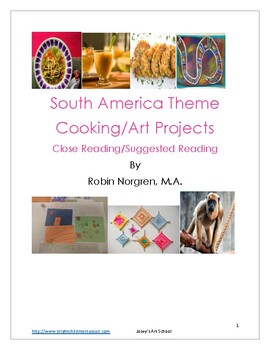South America Cooking Art Projects Close Reading Curriculum Pre-k to 6th
- PDF
Description
Are you looking for a comprehensive and engaging way to teach your students about the rich culture and diverse geography of South America? Look no further than our South America lesson bundle! This bundle includes six art lessons, six close reading essays, eight book recommendations, and five cooking ideas that will transport your students on a journey through the vibrant and fascinating continent of South America.
Using easy-to-follow instructions and step-by-step demonstrations, students will learn how to create beautiful works of art inspired by South American culture, such as weaving, pottery, and mask-making. They will also explore the history, geography, and traditions of South America through close reading essays and book recommendations that feature diverse voices and perspectives.
But the benefits of this lesson bundle don't stop there - it also offers multiple opportunities to integrate it into other areas of your curriculum. Here are four ways you can use this lesson bundle to enhance learning in your classroom:
- Social Studies - Use this lesson bundle as a starting point for a unit on South America, exploring the geography, history, and cultural diversity of the continent. Encourage your students to compare and contrast different regions of South America and to think critically about the impact of colonization and globalization on the continent.
- Language Arts - Use the lesson bundle to inspire creative writing and storytelling. Encourage your students to write stories or poems inspired by the art and literature of South America, or to research and write essays about historical figures and events.
- Math - Use the lesson bundle to teach your students about measurement, geometry, and patterns. Encourage them to explore the patterns and designs found in South American art and textiles, and to experiment with different shapes and sizes in their own art projects.
- Science - Use the lesson bundle to teach your students about the natural world of South America. Encourage them to research and learn about the different ecosystems, animals, and plants found on the continent, and to use this knowledge to create art and cooking projects inspired by the natural world.
- This South America lesson bundle is a wonderful way to promote creativity, critical thinking, and hands-on learning in your classroom. Order it today and inspire your students to explore the beauty and diversity of South America through art, literature, and culture!
Inside you will find:
Table of Contents
Cooking…………………………….. 3
Art …………………………………….9
Suggested books………………… 25
Bio …………………………………..28
5 cooking ideas
6 art lessons
6 close reading essays
8 book recommendations
CLICK HERE to view my freebies
CLICK HERE to view my DRAWING LESSONS
CLICK HERE to view my ART WITH THE MASTERS ART LESSONS
CLICK HERE to view my CONTEMPORARY ART LESSONS
CLICK HERE to view my ART LESSONS THAT COMPLIMENT POPULAR BOOKS
CLICK HERE to view my SELF ESTEEM PROJECTS
CLICK HERE to view my CLASS MURAL IDEAS
CLICK HERE to view my FUN ART FOLK ART LESSONS
CLICK HERE to view my 3 BUNDLED LESSONS
CLICK HERE to view my 5 BUNDLED LESSONS
Make sure to click the GREEN STAR near my store name so that you can stay in touch with my store. I create new lessons every week.





